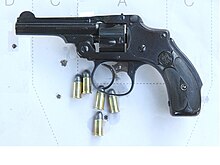
A revolver is a repeating handgun that has at least one barrel and uses a revolving cylinder containing multiple chambers for firing. Because most revolver models hold up to six cartridges before needing to be reloaded, revolvers are also commonly called six shooters.

Smith & Wesson Brands, Inc. (S&W) is an American firearm manufacturer headquartered in Springfield, Massachusetts, United States.

The Colt Single Action Army is a single-action revolver handgun. It was designed for the U.S. government service revolver trials of 1872 by Colt's Patent Firearms Manufacturing Company and was adopted as the standard-issued pistol of the U.S. Army from 1873 until 1892.
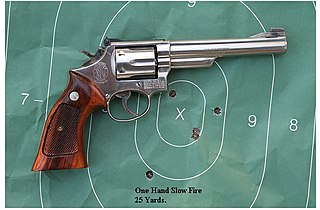
The Smith & Wesson Model 19 is a revolver produced by Smith & Wesson that was introduced in 1957 on its K-frame. The Model 19 is chambered for .357 Magnum. The K-frame is somewhat smaller and lighter than the original N-frame .357, usually known as the Smith & Wesson Model 27. A stainless steel variant of the Model 19, the Smith & Wesson Model 66, was introduced in 1971.

The Smith & Wesson Model 10, previously known as the Smith & Wesson .38 Hand Ejector Model of 1899, the Smith & Wesson Military & Police or the Smith & Wesson Victory Model, is a K-frame revolver of worldwide popularity. In production since 1899, the Model 10 is a six-shot, .38 Special, double-action revolver with fixed sights. Over its long production run it has been available with barrel lengths of 2 in (51 mm), 3 in (76 mm), 4 in (100 mm), 5 in (130 mm), and 6 in (150 mm). Barrels of 2.5 inches (64 mm) are also known to have been made for special contracts. Some 6,000,000 of the type have been produced over the years, making it the most produced handgun of the 20th century.

The Smith & Wesson Model 586, is a six- or seven-shot double-action revolver chambered for the .357 Magnum cartridge; it will also chamber and fire .38 Special cartridges. The Model 586 has a carbon steel construction and is available in a blued or nickel finish; it is essentially the same firearm as the Model 686, which has stainless steel construction. It is also known as the Distinguished Combat Magnum.

H&R 1871, LLC, or more commonly known as Harrington & Richardson, is an American brand of firearms and a subsidiary of JJE Capital Holdings. H&R ceased independent production February 27, 2015.

In American English, a pocket pistol is any small, pocket-sized semi-automatic pistol, and is suitable for concealed carry in a pocket or similar space.
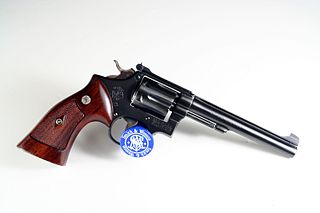
The Smith & Wesson Model 17 is a six-shot double-action revolver chambered for .22 LR. It is built on Smith & Wesson's medium-sized K-frame.
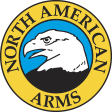
North American Arms is a United States company, headquartered in Provo, Utah, that manufactures pocket pistols and mini-revolvers, also called mouse guns. The company was originally named Rocky Mountain Arms when it was founded in 1972. In 1974 it was bought by new owners who renamed the company North American Manufacturing (NAM) and then North American Arms (NAA).

A snubnosed revolver is a small, medium, or large frame revolver with a short barrel, generally less than 4 inches in length. Smaller such revolvers are often made with "bobbed" or "shrouded" hammers and there are also "hammerless" models ; the point is to allow the gun to be drawn with little risk of it snagging on clothing. Since the external movement of the mechanism is minimal or nil, shrouded and hammerless models may be fired from within clothing. The design of these revolvers compromises range and accuracy at a distance in favor of maneuverability and ease of carry and concealment.

The Remington-Beals Model Revolvers along with subsequent models and variations were percussion revolvers manufactured by Eliphalet Remington & Sons in .31 (Pocket) .36 (Navy) or .44 (Army) caliber, used during the American Civil War, and was the beginning of a successful line of medium and large frame pistols. They are commonly, though inaccurately, referred to as the Model 1858 due to the patent markings on its New Model barrels, "PATENTED SEPT. 14, 1858/E. REMINGTON & SONS, ILION, NEW YORK, U.S.A./NEW MODEL."; although wide scale production did not start until 1861.

S&W Centennial is a family of revolvers made by Smith & Wesson on the "J-Frame". Depending upon caliber, the cylinder holds either 5, 6, 7, or 8 cartridges. Centennials feature a fully enclosed (internal) hammer, which makes them Double Action Only (DAO) firearms. Like all other "J-frame" Smith & Wesson revolvers, they have a swing-out cylinder. Centennial models have been made in different versions like PD "Personal Defense", LS "Lady Smith", and M&P "Military & Police"

A handgun is a firearm designed to be usable with only one hand. It is distinguished from a long gun which needs to be held by both hands and braced against the shoulder. The two most common types of handguns are revolvers and semi-automatic pistols, although other types such as derringers and machine pistols also see infrequent usage.

The Model 610 is a six-shot, double-action revolver chambered for the 10mm Auto cartridge.

The Colt Police Positive is a small-frame, double-action revolver featuring a six-round cylinder, chambered for either .32 or .38 caliber. A .22 caliber model was also offered. Designed primarily for sale to federal, state, or local law enforcement agencies, the Police Positive was introduced into the firearms market by Colt's Manufacturing Company in 1905.
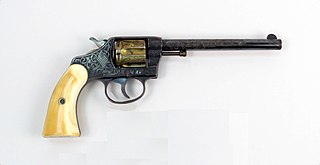
The Colt New Police is a double-action, six-shot revolver. This gun was chambered in the .32 New Police, which is dimensionally identical to a flat-nose version of the .32 S&W Long, except for the nose shape. In addition to the .32 New Police cartridge, the revolver was available in 32 Colt. The diameters of the two cartridges are not the same, with the 32 Colt being approximately 0.020 inches smaller in diameter than the New Police. Although the 32 Colt can be loaded and fired in the New Police chamber, it is not recommended to do so. It is impossible to load the .32 New Police in a 32 Colt chamber. The later .32 New Police chambering was more popular than the 32 Colt chambering.

Merwin, Hulbert, and Co. or Merwin Hulbert was an American firearms designer and marketer based in New York City which produced revolvers and rifles from 1874 to 1896. The firearms were manufactured by a subsidiary company, Hopkins & Allen of Norwich, Connecticut. Merwin Hulbert's designs had influenced other gunmakers of the time, such as Meriden Firearms Co., Harrington & Richardson, Forehand & Wadsworth, and Iver Johnson.

The Smith & Wesson Model 1+1⁄2 was Smith & Wesson's second .32 caliber revolver, intended to combine the small size and convenience of the .22 caliber Model 1 with the larger caliber of the 6-shot "belt sized" Model 2, which was introduced in 1861. Chambered in .32 Rimfire, its cylinder held 5 shots. It was produced in three varieties from 1865 through 1892, with total production exceeding 223,000.
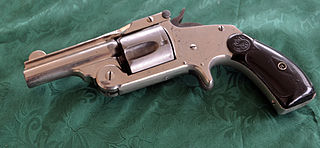
The Smith & Wesson Model 2, also referred to as the Smith & Wesson .38 Single Action, was a .38 caliber revolver produced in both single and double action by Smith & Wesson. The manufacturer's first of that caliber, its 5-shot cyclinder was chambered in .38 S&W. The single-action was produced in three varieties from 1876 through 1911, with total production exceeding 223,000 units; the double-action in three variants from 1880 to 1913, with total sales somewhat under one-million guns.

